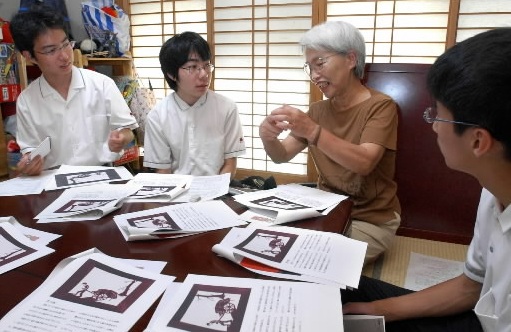Conveying the A-bomb Experience, Part 7
Jul. 5, 2010
A-bomb survivors convey experiences to next generation through art
by Kunihiko Sakurai, Masaki Kadowaki, and Takahiro Yamase, Staff Writers
The heat of the atomic fire, the agony of burned bodies, the grief wrought by families torn apart, the rage felt toward war… What should be done to etch the experiences borne of that day in our minds and in our memories, for generations to come, as the A-bomb survivors (hibakusha) and the family members of the A-bomb victims age? In this series (originally published in July and August 2004), the Chugoku Shimbun will consider the significance and challenges of conveying the A-bomb experience, with a focus on new efforts taking place in the A-bombed city of Hiroshima.
An eerie fire that looked like fresh blood reddened the sky and was on the verge of devouring the hill. It raged on the night of August 6 at Ochigo Hill, about 3.5 kilometers east of the hypocenter of the atomic bomb. Kuniko Hirai, 68, a resident of Nishi Ward, later made a picture of the scene that had been scored deeply in her mind, using paper cutouts.
On July 25, three high school students, including Kazuhiro Ishida, 16, a first-year student at Hiroshima Johoku High School in Higashi Ward, visited Ms. Hirai's home. "Please tell us about your memories from that time and the feelings you put into your pictures," began Kazuhiro, his voice a bit shaky.
"When I looked back at the hill I had just climbed over, I felt as if the red sky was set to attack me," Ms. Hirai said. "I still find the color red frightening." That night, when she was nine years old, she lost her father, her older brother, and her older sister. As Ms. Hirai grew emotional, her precise way of speaking changed and her voice became a bit strained.
She has created six pictures using paper cutouts. In one, Ms. Hirai depicted a woman who died while holding her baby in her arms. This is an example of a scene that she depicted faithfully based on her experience of the bombing. In another picture, which shows a dead horse, she added a lotus flower to the scene to express pity for the creature.
The three students simply listened to her quietly. Overwhelmed by the vivid description of her account, they were at a loss for words. "We could only listen to her story," they said. "We were unable to ask questions as we had hoped." Even after leaving Ms. Hirai's home, their faces showed regret.
Ms. Hirai said, "I thought they would shrink back in the middle of my account. I'm glad they listened to me until the end." She bowed again and again to the students and bid them goodbye.
Ms. Hirai's pictures are among the more than 2,200 "A-bomb pictures" created by about 750 people, which were submitted in response to a call by NHK (Japan Broadcasting Corporation) to A-bomb survivors across Japan in 1974 and 1975.
The effort to visit those who created the pictures was launched individually by Akiko Naono, 32, in 2001. Ms. Naono is a resident of Nishinomiya City in Hyogo Prefecture and a member of the Materials Research Committee at Hiroshima Peace Memorial Museum. She lost one of her grandfathers in the atomic bombing and, because she was born after the war, had no chance to know him. She began interviewing survivors who made pictures in an attempt to understand the sacrifice made by her grandfather.
To date, the whereabouts of about 170 of the 750 hibakusha have been discovered. Ms. Naono has finished interviewing just 50 of them. She finds it encouraging, though, as she has been feeling pressed for time, that high school students in Hiroshima who learned about her effort have joined the project.
Taeko Teramae, 75, a resident of Asaminami Ward, is one of those who made a drawing. She said, "I tried to draw a picture of what I saw that day, but it's like a picture drawn by a kindergartener and has no impact." Since June of this year, she has been involved in creating a new A-bomb picture with students at Hiroshima City University in Asaminami Ward.
Ms. Teramae was exposed to the atomic bombing at the Hiroshima Central Telephone Exchange, only 540 meters from the hypocenter. The students, who have no experience of the war, will interview her about her memories and make a painting based on this information.
Hamako Eno, 43, a staff member in the Outreach Division of Hiroshima Peace Memorial Museum and the initiator of the art project, was at first concerned that "scenes which didn't actually happen might be created." This fear, though, quickly turned out to be unwarranted. "Smiles have appeared on their faces from time to time during serious conversations," she said. "Dialogues beyond generations began to develop through the joint effort aimed at preserving the A-bomb experiences." She now believes this outcome is of greater importance than the quality of the paintings.
(Originally published on July 28, 2004)








